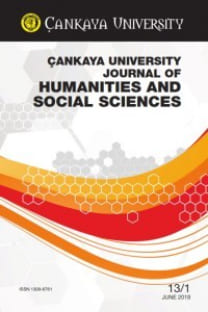Gottfried Benn Şiiri ve Dışavurumcu İmge
Gottfried Benn, Dışavurumculuk, Şiir, İmge, Lirik
Gottfried Benn’s Poetry and Unbracketing the Expressionist Image
Gottfried Benn, Expressionism, Poetry, Imagery, Lyric,
___
- Adorno, Theodor W. Aesthetic Theory (trans. by Robert Hullot-Kentor). Continuum, 2002.
- Altieri, Charles. “The Concept of Expression in the Arts from a Wittgensteinian Perspective.” Wittgenstein and Modernism. Ed. Michael Lemahieu and Karen Zumhagen-Yekple. The University of Chicago Press, 2016, pp. 57-70.
- Anglet, Andreas. “The Café in Benn's and Apollinaire's Lyrical Focalisations of the City.” KulturPoetik, Vol. 7, No. 2, 2007, pp. 215-233.
- Bachmann, Ingeborg. “A Translation of "Das Schreibende Ich," a Lecture on the First-Person Narrator by Ingeborg Bachmann” (trans. by Douglas Robertson). http://shirtysleeves.blogspot.com/2017/10/a-translation-of-das-schreibende-ich.html.
- Bachmann, Ingeborg. “Das schreibende Ich.” Werke (IV). Ed. Christine Koschel, Inge von Weidenbaum, and Clemens Münster. R. P.er & Co. Verlag, 1993, pp. 217-237.
- Badiou, Alain. Handbook of Inaesthetics (trans. by A. Toscano). Stanford University Press, 2005.
- Bahr, Hermann. Expressionism (trans. R. T. Gribble). Anchor Book, 1953.
- Benn, Gottfried. Gesammelte Werke. Limes Verlag, 1966.
- Benn, Gottfried. Primal Vision: Selected Writings. Ed. E.B. Ashton. New Directions, 1971.
- Benn, Gottfried. Probleme der Lyrik. Limes Verlag: 1954.
- Benn, Gottfried. Gottfried Benn: Prose, Essays, Poems. Ed. Volkmar Sander. Continuum, 1987.
- Hannum, Hunter G. “George and Benn: The Autumnal Vision.” PMLA, Vol. 78, No. 3, 1963, pp. 271-279.
- Hejinian, Lyn. My Life. Sun & Moon Press: 1987.
- Höcker, Arne. “Brainless: Scientific Observation and Literary Writing in Gottfried Benn.” Monatshefte, Vol. 105, No. 3, 2013, pp. 458-471.
- Holthusen, Hans Egon. “German Lyric Poetry since 1945” (trans. Herman Salinger). Poetry, Vol. 88, No. 4, 1956, pp. 257-266.
- Kripke, Saul A. Wittgenstein on Rules and Private Language: An Elementary Exposition. Basil Blackwell, 1982.
- Lohner, Edgar. “The Development of Gottfried Benn’s Idea of Expression as Value.” The German Quarterly, Vol. 26, No. 1, 1953, pp. 39-54.
- Loose, Gerhard. “Gottfried Benn and the Problem of Art in Our Time.” Criticism, Vol. 4, No. 4, 1962, pp. 340-362.
- Richards, I. A. The Philosophy of Rhetoric. Oxford University Press, 1946.
- Roche, Mark W. “Christ as the Lost I: Multiple Interpretations of Gottfried Benn's Poem ‘Verlorenes Ich.’” Religion & Literature, Vol. 34, No. 3, 2002, pp. 27-56.
- Roche, Mark W. Gottfried Benn's Static Poetry. University of North Carolina Press, 1991.
- Schlossman, Beryl F. “Figures Transfigured: Madonnas of Modernism, Altars of the Sublime.” Ulysse à l’article: Joyce aux marges du roman. Ed. Daniel Ferrer, Claude Jacquet, André Topia, Tusson Charente. Du Lérot, 1991, pp. 221-254.
- Smith, Norman Kemp. “The Fruitfulness of the Abstract.” The Credibility of Divine Existence. St. Martin’s Press, 1967, pp. 324-338.
- Travers, Martin. The Poetry of Gottfried Benn: Text and Selfhood. Peter Lang, 2007.
- Travers, Martin. The Poetry of Gottfried Benn: Text and Selfhood. Peter Lang, 2007.
- Trilling, Lionel. The Liberal Imagination: Essays on Literature and Society. Anchor Books, 1953.
- Valéry, Paul. “Degas, Danse, Dessin.” Degas Manet Morisot (trans. David Paul). Pantheon Books, 1960.
- Wilbur, Richard. Responses: Prose Pieces, 1953-1976. Story Line Press, 2000.
- ISSN: 1309-6761
- Yayın Aralığı: Yılda 2 Sayı
- Başlangıç: 2004
- Yayıncı: Çankaya Üniversitesi
Post-editing Eğitimi, Acemi Post-editörlerin Performansını Etkiliyor mu? Deneysel Bir Çalışma
Volkan DEDE, Elena ANTONOVA-ÜNLÜ
Travma Geçirmiş Göçmen: Monica Ali’nin Brick Lane’i
William Golding’in The Inheritors Romanında Bireyleşme Süreci: Duygulanım ve “Öteki”yle Karşılaşma
Dünya Sakini Hayvanın Dünyadan Dışlanması: Orta Çağ Mister Oyunlarında Hayvanların Temsili
Gottfried Benn Şiiri ve Dışavurumcu İmge
Kadın Dergilerinde Tavsiye Yazıları
Reem LULU, Sharifah Nurul Huda ALKAFF
